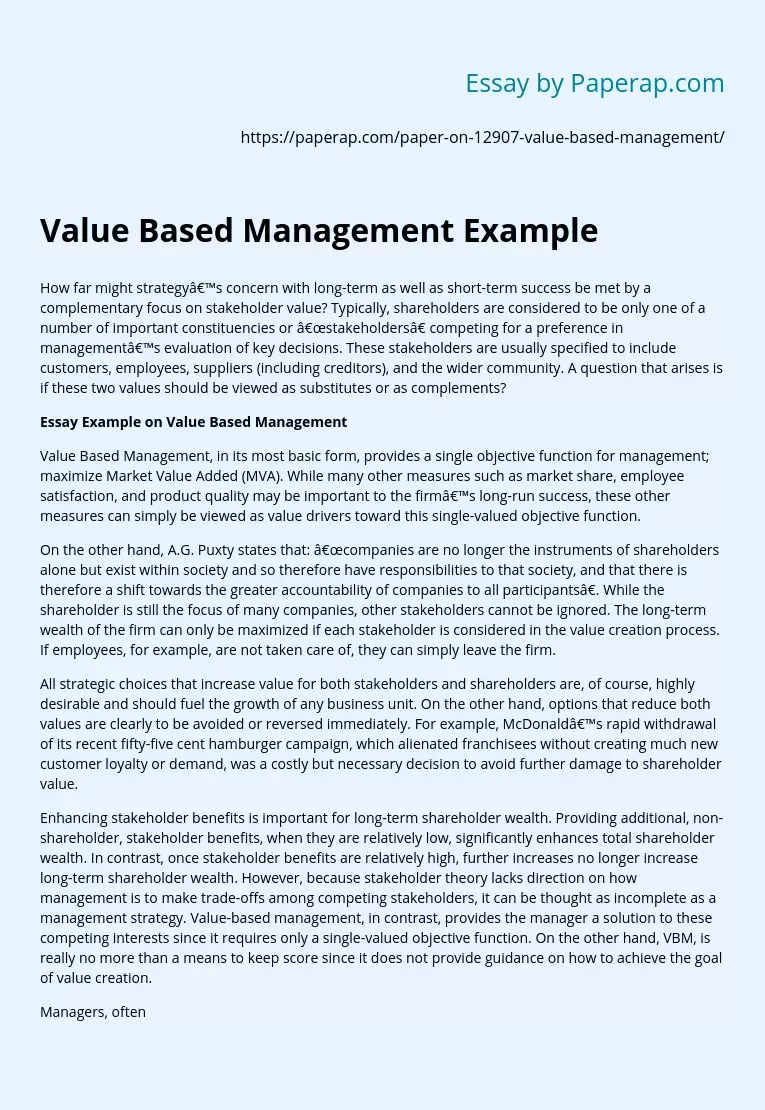Value Based Management Example
The following sample essay on Value Based Management Example. How far might strategy’s concern with long-term as well as short-term success be met by a complementary focus on stakeholder value? Typically, shareholders are considered to be only one of a number of important constituencies or “stakeholders” competing for a preference in management’s evaluation of key decisions. These stakeholders are usually specified to include customers, employees, suppliers (including creditors), and the wider community. A question that arises is if these two values should be viewed as substitutes or as complements?
Value Based Management, in its most basic form, provides a single objective function for management; maximize Market Value Added (MVA).
While many other measures such as market share, employee satisfaction, and product quality may be important to the firm’s long-run success, these other measures can simply be viewed as value drivers toward this single-valued objective function.
On the other hand, A.G. Puxty states that: “companies are no longer the instruments of shareholders alone but exist within society and so therefore have responsibilities to that society, and that there is therefore a shift towards the greater accountability of companies to all participants”.
While the shareholder is still the focus of many companies, other stakeholders cannot be ignored. The long-term wealth of the firm can only be maximized if each stakeholder is considered in the value creation process. If employees, for example, are not taken care of, they can simply leave the firm.
All strategic choices that increase value for both stakeholders and shareholders are, of course, highly desirable and should fuel the growth of any business unit.
On the other hand, options that reduce both values are clearly to be avoided or reversed immediately. For example, McDonald’s rapid withdrawal of its recent fifty-five cent hamburger campaign, which alienated franchisees without creating much new customer loyalty or demand, was a costly but necessary decision to avoid further damage to shareholder value.
Enhancing stakeholder benefits is important for long-term shareholder wealth. Providing additional, non-shareholder, stakeholder benefits, when they are relatively low, significantly enhances total shareholder wealth. In contrast, once stakeholder benefits are relatively high, further increases no longer increase long-term shareholder wealth. However, because stakeholder theory lacks direction on how management is to make trade-offs among competing stakeholders, it can be thought as incomplete as a management strategy. Value-based management, in contrast, provides the manager a solution to these competing interests since it requires only a single-valued objective function. On the other hand, VBM, is really no more than a means to keep score since it does not provide guidance on how to achieve the goal of value creation.
Managers, often face choices that involve real tradeoffs between stakeholder and shareholder value. These choices need to be made on the basis of their expected impact on shareholder value alone. If a proposal to increase customers or customer value will reduce shareholder value, then it should be rejected. For instance, we commonly find that clients offer product features or delivery options that customers appreciate but for which they will not, in fact, pay.
Nevertheless, the shareholder is the central stakeholder. Placing the shareholder at the focal point of business activity is simply recognizing the fact that firms that do not satisfy shareholder requirements increase their risk of capital flight, higher interest rates, pressure from the board of directors, takeovers, and lower productivity. Organizations that create long-term shareholder value simultaneously create relatively greater value for all stakeholders.
Thus, value-creating organizations appear to operate with the following objective function in mind: Maximize shareholder wealth subject to satisfying remaining stakeholder requirements. I believe that a company’s success ultimately depends on its ability to build and nurture relationships with constituents that are essential to their business: consumers, customers, suppliers, partners, government authorities, communities, employees and share owners. This will enable them to achieve their objectives of creating economic value added by improving economic profit.
BIBLIOGRAPHY
- “Value-Based Management: Developing a Systematic Approach to Creating Shareholder Value”, James A. Knight (1998), McGraw-Hill
- “How “Shareholder Value” Let Shareholders Down”, Ken Favaro.
- “The quest for value: A guide for senior managers”, Stewart G B (1991), Harper Collins.
Value Based Management Example. (2019, Nov 27). Retrieved from https://paperap.com/paper-on-12907-value-based-management/

